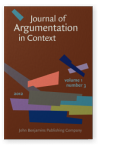Vol. 1:3 (2012) ► pp.331–377
Strategic maneuvering in diplomatic mediation
In diplomatic mediation, dissociation and definitions become tools of the mediator’s strategic maneuvering by means of which the disputants’ disagreement space is minimized, decision-making being thus facilitated. The mediator’s argumentative behavior is explored, investigating the way in which he succeeds in “maintaining a delicate balance” (van Eemeren and Houtlosser 2002) between the dialectical and the rhetorical aims in accordance with the institutional aim specific to mediation as an activity type. In order to argue reasonably and efficiently, the mediator assumes certain roles and adopts and develops a set of strategies in compliance with the goal and constraints of the particular activity type he argues within. Consequently, the mediator builds his argumentation case in full awareness of the specific circumstances, and of the types of constraints of the case, by making a pertinent choice from the topical potential, adjusting it to the particular audience, and exploiting the range of presentational devices accordingly.
Cited by (2)
Cited by 2 other publications
This list is based on CrossRef data as of 4 july 2024. Please note that it may not be complete. Sources presented here have been supplied by the respective publishers. Any errors therein should be reported to them.
